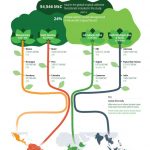Indigenous lands are even more critical to preserving the Earth than we thought

Nearly one quarter of the carbon stored above ground in tropical forests is currently in the care of indigenous and traditional communities. A new report suggests that keeping those populations on the land and guaranteeing their right to it could be the key to keeping some 54.5 billion metric tons of carbon—equivalent to four times the total global carbon emissions in 2014—in storage and, more importantly, out of the atmosphere. The latest in a series of carbon mapping reports from the Rights and Resources Initiative, Woods Hole Research Center, and World Resources Institute has quantified the amount of carbon stored in tropical forests and, a week ahead of the COP 22 meeting in Marrakech, has drawn attention to the role that forest communities could play in helping national governments meet emission reduction goals. “Tropical forests represent some of the most carbon-rich landscapes on the planet,” said Wayne Walker, a scientist with the Woods Hole Research Center and co-author of the report. “As the traditional stewards of these forests, why shouldn’t [these communities] be allowed to continue to play that role of maintaining them, as they have for hundreds and thousands of years?”

